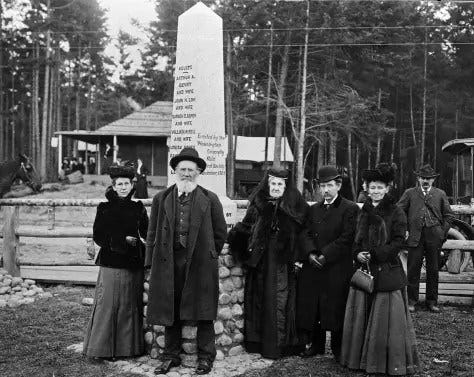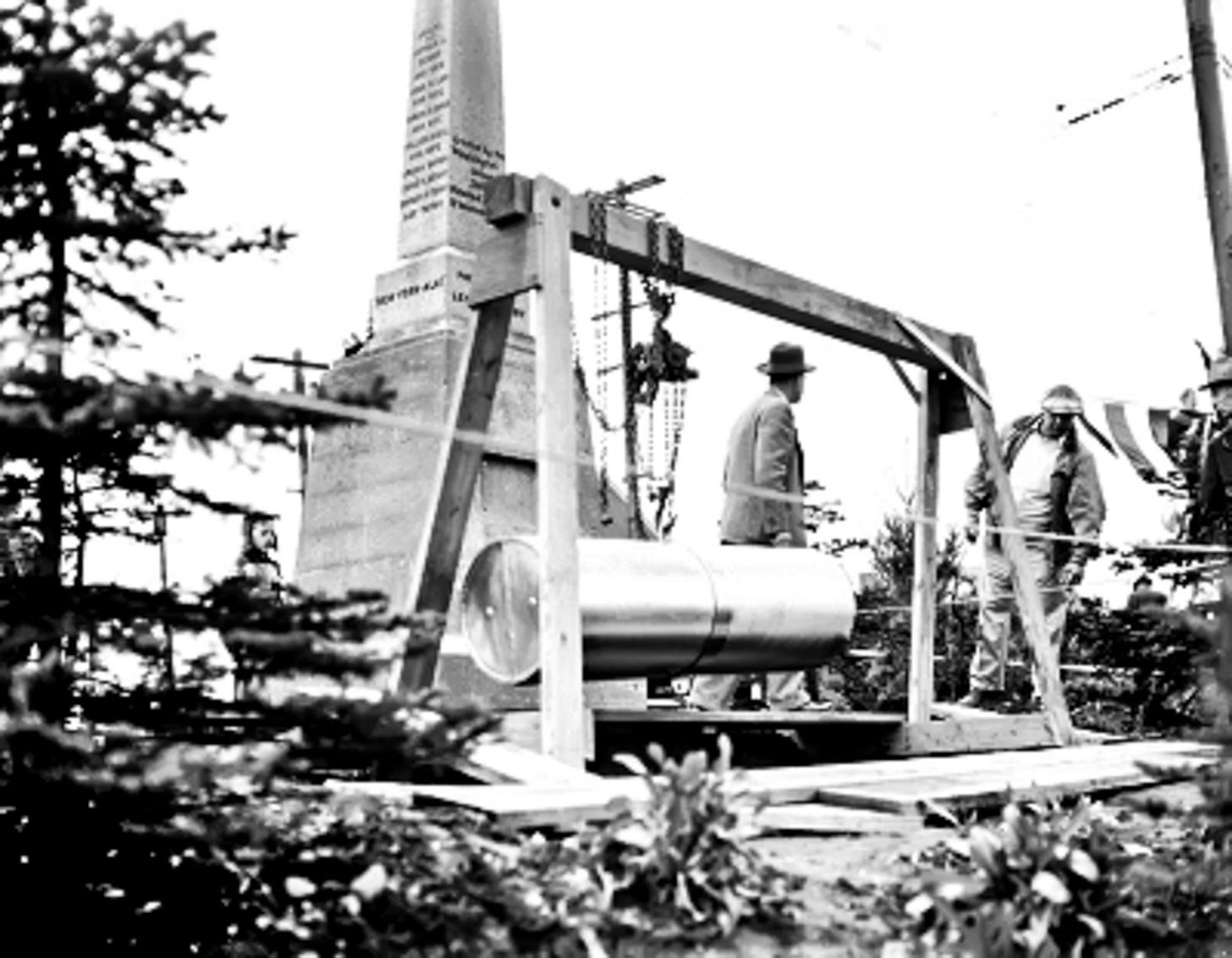Hundreds of people walk past the Birthplace of Seattle monument on Alki Beach most days (probably thousands daily during summer) and never stop to read the inscriptions, if the monument even registers in their minds. Carved in stone, the monument emphatically states “At this place on 13 November 1851 there landed from the schooner Exact Captain Folger the little colony which developed into the City of Seattle”.
The Birthplace of Seattle Monument on Alki Avenue SW at 63 Avenue SW was erected catty-corner across the intersection November 13, 1905. 1905 was the fifty-fourth anniversary of the Arthur A. Denny Party landing on Alki, not the fiftieth which would have been four years earlier in 1901. So, why 1905 instead on 1901, which seemingly would have been more significant?
The simple answer is, progress. In 1901 the Alki area had reverted to a roadless wilderness of second-growth forest. The town of Alki (originally called New York, then New York Alki, a Chinook Jargon word meaning by and by or eventually) established 1853 on Alki Point, had withered away by 1857 when the town’s founder Charles Terry traded his Alki land claim to Seattle pioneer David Swinson “Doc” Maynard for Maynard’s downtown Seattle land claim. Trying his hand at farming, Doc Maynard’s experimental potato farm using Alki Beach kelp for fertilizer failed by 1868, causing the good doctor to move back across Elliott Bay. The company “town” of West Seattle, established 1888 as a San Francisco real estate venture, then centered across the peninsula on today’s Harbor (then Railroad) Avenue would not be incorporated as a real town for another year, until 1902. The only “road” to Alki at the turn of the last century was Alki beach, dependent on tides and weather. Most residents of Alki Beach were predominantly summer vacationers living in beach tents or in rough cabins on pilings. The Duwamish people who once resided around the West Seattle peninsula had relocated to the Seattle waterfront or moved to reservations. For the first time since the last Ice Age 15,000 years ago the Alki area was a true wilderness.
In 1905, the year before the Town of West Seattle voted to approve annexation by the City of Seattle, King County platted the first road above Alki Beach, the forerunner of today’s Alki Avenue. To take advantage of the new road and influx of summer visitors to Alki Beach two resorts opened along the beach, the rustic Stockade Hotel in 1904, constructed of logs salvaged from Alki Beach, and Alki’s first saltwater natatorium at Alki Point in 1905. To compliment the West Seattle Ferry established 1888 along with the company town of West Seattle, the Alki Transportation Company provided additional ferry service directly to Alki Beach to serve the new resorts. Alfred and Lenora Smith, the owners of the Stockade Hotel, which became famous for its chicken dinners, concocted the idea of staging a publicity event at their resort November 13, 1905, featuring the surviving members of the Denny Party.
Unsigned photograph of Stockade Hotel following construction of the Alki Point streetcar line which reached Alki Beach in 1908. Photograph shows the streetcar tracks turning south off Alki Avenue onto 63rd Avenue SW. Photograph courtesy Seattle Room Seattle Public Library.
Charles Boren standing in front of the Birthplace of Seattle Monument. Unsigned photograph November 13, 1905. Photograph courtesy Seattle Room Seattle Public Library. To Boren’s left stands Arthur Denny’s widow Mary Ann Denny. To her left her son Roland Herschel Denny, six weeks old when the Denny Party landed at Alki Point.
Unsigned photograph capturing the unveiling of the Birthplace of Seattle Monument November 13, 1905. Photograph courtesy Seattle Room Seattle Public Library. Photograph was snapped from the balcony of the Stockade Hotel. Note the beach house where the monument is located today. Alki Avenue was a newly constructed dirt and mud road. Alki Beach at the time was private property and would remain so until the City of Seattle condemned 2,200 feet of beach front in 1910 to create Alki Beach Park.
Five-foot long lead time capsule buried on the beach side of the Birthplace of Seattle Monument during the centennial celebration of the Denny Party landing. Seattle Municipal Archives Engineering Department Negatives November 13, 1951, Identifier: 43477. The Birthplace of Seattle Monument had been moved to its current location on Alki Beach in 1926 during the seventy-fifth anniversary celebration of the Denny Party landing in the face of a building boom across Alki during the original Roaring Twenties which saw West Seattle change from a summer vacation playground to a permanent residential neighborhood.
Reenactment at Alki Beach of the Denny Party landing during the centennial celebration. People dressed as Plains Indians who I am pretty sure were not even Duwamish stood in for Chief Seattle and his Duwamish people who created Arthur Denny and his party when they came ashore. Seattle Municipal Archives Engineering Department Negatives November 13, 1951, Identifier: 43478.
Faux cabin erected for the centennial celebration of the Denny Party landing purported to be a representation of the original Denny cabin. Seattle Municipal Archives Engineering Department Negatives November 13, 1951, Identifier: 43481. Only thing they got right was the lack of a roof.
Southeast corner of Alki Avenue SW and 63rd Avenue SW, site of the Stockade Hotel, with Denny Cabin plaque, purporting to mark the location of the original Denny Cabin.
Coming across the Oregon Trail from Illinois in 1851, the Arthur Denny party stopped in Portland to rest after Arthur Denny fell ill and his wife Mary Ann Boren Denny became ready to deliver their third child, Rolland Herschell Denny. Arthur dispatched his younger brother David, along with John Low, to sail on to Puget Sound to scout a suitable site for a settlement. Along the way New Yorker Lee (Leander) Terry joined the two. By coincidence Lee Terry’s younger brother Charles Terry joined Arthur Denny’s party in Portland.
David Denny, John Low, and Lee Terry arrived at Duwamish Head September 25, 1851 where they met Chief Seattle and his Duwamish people camped to gather shellfish. While David Denny liked Duwamish Head as a site for a settlement, Low and Terry outvoted him. Three days later, after surveying the Duwamish River, the trio paddled to Alki Point where Lee Terry proclaimed the townsite of New York in honor of his home state. Only nineteen years old, David could only watch helplessly as Lee Terry and John Low promptly staked land claims under the 1850 Oregon Donation Land Claim Act, applicable to white homesteaders at least twenty-one years of age. At the time Puget Sound was part of Oregon Territory.
John Low headed back to Portland to alert Arthur Denny that he and David had found a suitable home site. Lee Terry took off for the settlement of Olympia, sporting Puget Sound’s only store, to purchase a shake axe for making shingles for their cabins. This left David Denny to build the first cabin by himself. David bribed local Duwamish Indians with bread, a delicacy to them, to assist him with lifting logs into place. The walls raised, but the cabin still roofless as November rains moved into Puget Sound, David severely injured his foot while cutting a log with his axe and fell seriously ill. He crawled into a thatch tent on the beach to recuperate. On the morning of November 13, 1851, David awoke in his tent to the sound of an anchor chain dropping into the water. He crawled out of his tent to find the schooner Exact anchored before him, his brother Arthur and the rest of the Denny Party disembarking in pouring rain. Making his way down to the beach David greeted Arthur with the words “I wish you hadn’t come.” According to the account of the landing written by David Denny’s future daughter Emily Inez Denny (first white girl born in Seattle in 1853), the women of the Denny Party, upon seeing the roofless cabin in the pouring rain, sat on a log on the beach and cried. Not the most auspicious start for the future city of Seattle.
This brings us back to the Birthplace of Seattle Monument’s inscription, “At this place on 13 November 1851. . .” Where exactly was “this place”? Alki Beach where the Birthplace of Seattle Monument was erected as a publicity stunt in 1905? Where the Denny Party landing was reenacted in 1951? And the location of the Denny Cabin plaque? Not likely. In 1851 old growth Douglas fir and redcedar forest barricaded Alki Beach and ringed Puget Sound. David Denny would want to build a cabin from where he could spot ships, such as the schooner Exact, sailing across Puget Sound. Alki Point, the future townsite of Alki, would be the perfect location. The landscape to the southeast of Alki Point was open prairie, providing unobstructed views of Puget Sound, the result of generations of burning by the Duwamish people. In fact, the Duwamish called Alki Point sbaqʷabqs in their Lushootseed language, meaning Prairie Point. Alki Point would have been the likely location of David Denny’s cabin and the Arthur Denny Party landing, November 13, 1851.
Circa 1891 photograph by pioneer Seattle photographer Frank La Roche of ruins of Arthur A. Denny cabin at Alki Point, not Alki Beach, not long before the cabin was demolished. Only known photograph of the Denny cabin. The trees behind the cabin suggest the view is northeasterly because the landscape to the southeast of Alki Point was open prairie, the result of generations of burning by the Duwamish people. University of Washington Digital Collections Frank La Roche Photograph Collection PH Coll 283 1891-1894-3.















